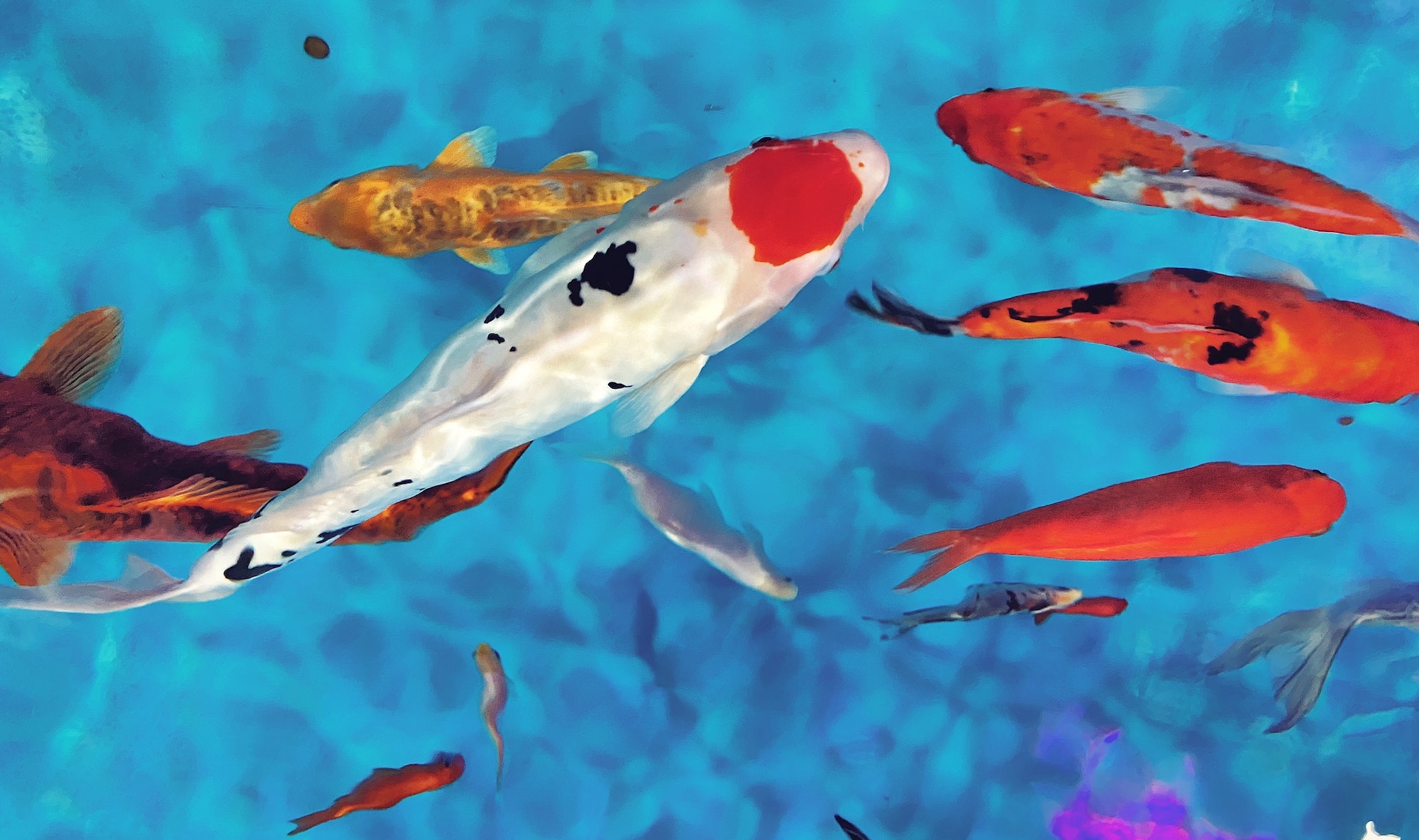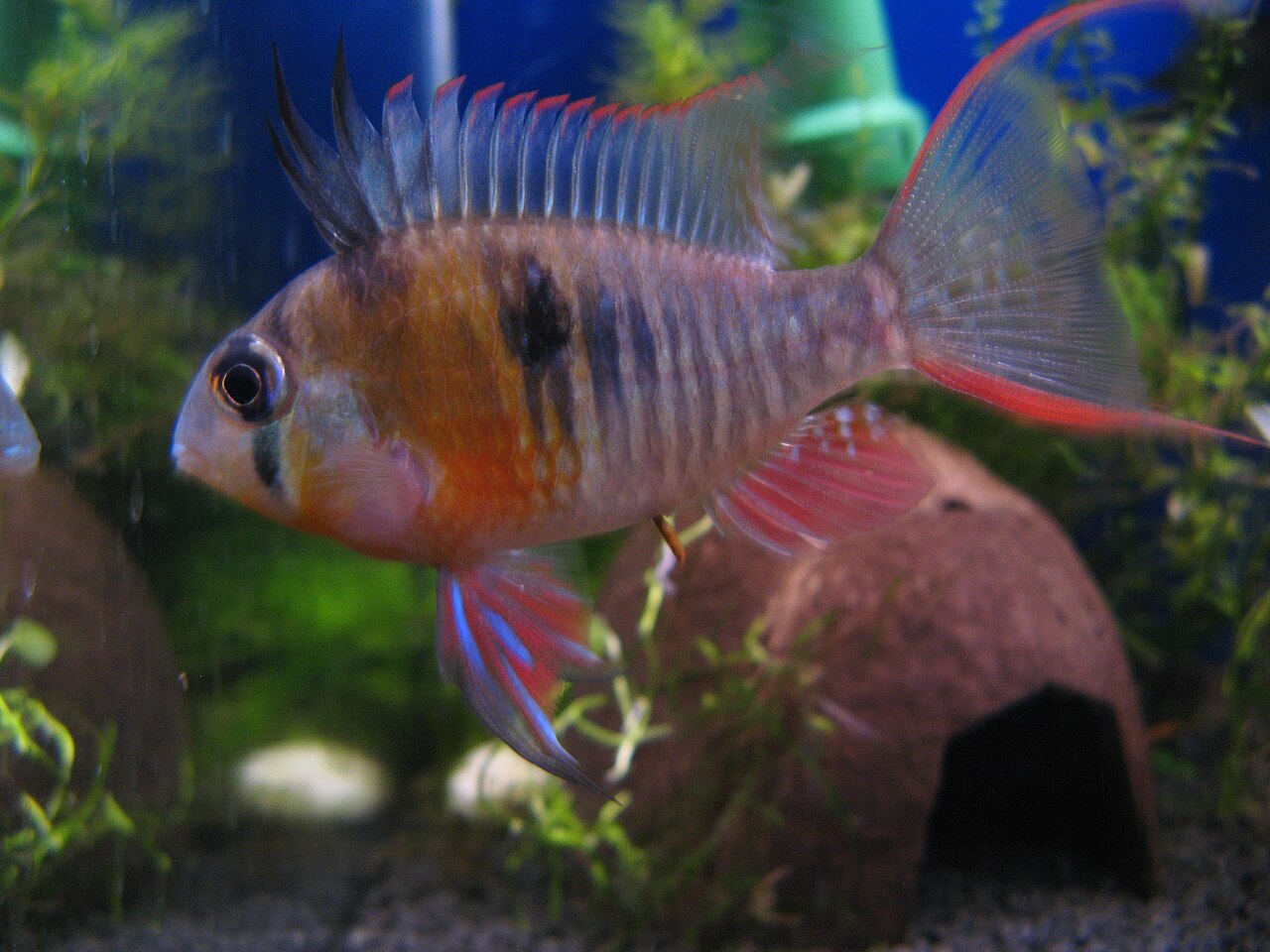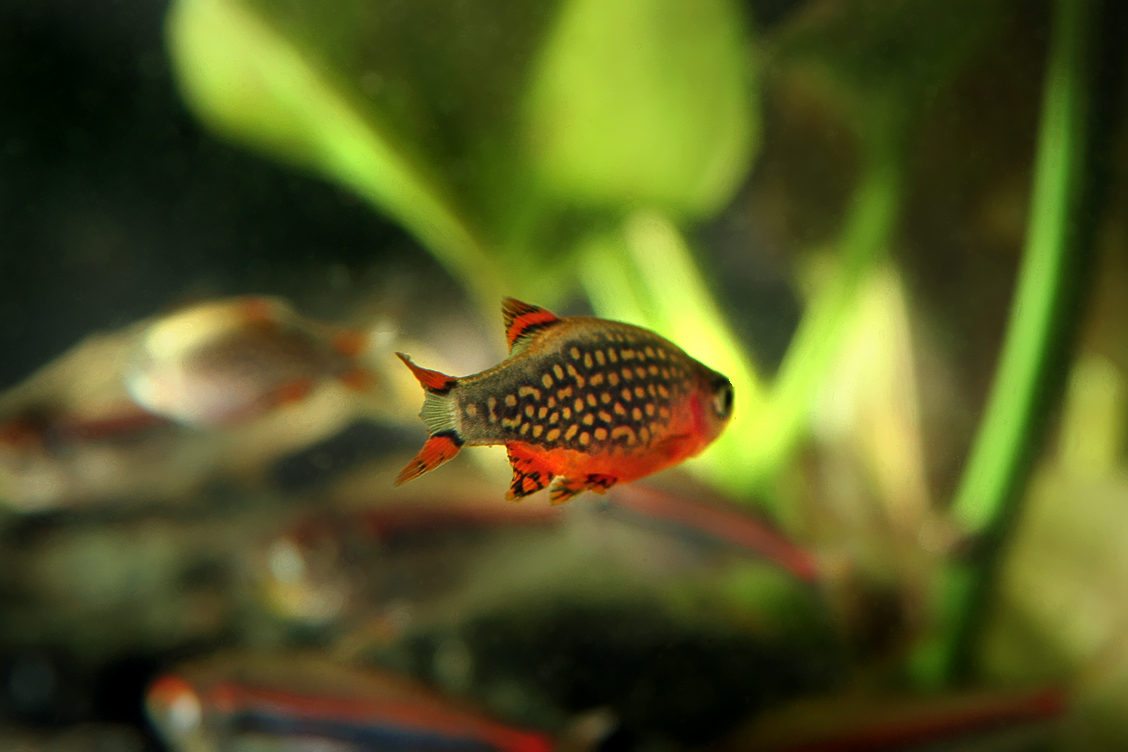Known scientifically as Cyprinus carpio, Koi Fish are a sight to behold in any water garden or pond. They’re not just visually appealing; their unique behavior and intriguing history add to their charm.
Koi Fish, or Nishikigoi as they’re known in Japan, are ornamental varieties of domesticated common carp. They belong to the Cyprinidae family, which also includes other familiar species like goldfish and minnows. The beauty of Koi Fish lies in their diverse colors and patterns. From white to black, red to yellow, blue to cream, the spectrum of colors is truly mesmerizing.
While Koi Fish are not considered rare, certain varieties and color patterns are indeed unique and highly sought after. For instance, the Platinum Ogon, a solid, metallic-white Koi, is a rare and prized variety. The world of Koi Fish is filled with such fascinating variants, each with its own unique charm.
Koi Fish are freshwater fish that thrive in outdoor ponds or water gardens. They’re generally bottom dwellers, but they’re not shy about coming to the surface, especially during feeding times. Koi are omnivorous and have a varied diet that includes peas, watermelon, lettuce, and commercial Koi Fish food. They’re friendly creatures and can often be seen eating out of their owner’s hands.
In terms of behavior and temperament, Koi Fish are peaceful and get along well with other fish. They’re also known for their longevity, with some Koi living for over 200 years. These fish are a symbol of love and friendship in Japan, and they have a strong homing instinct, often finding their way back to their original owners if moved.
Koi Fish can grow up to 3 feet in length and can weigh up to 35 pounds. They have a lifespan of around 25-35 years, but some Koi have been known to live for over 200 years. These fish are not just pets; they’re companions that can be with you for a lifetime.
The history of Koi Fish is as colorful as the fish themselves. Originating from China about 2,500 years ago, they were initially used as a food source. However, their potential as ornamental fish was soon recognized when color mutations began to appear. Today, Koi Fish are cherished all over the world, not just for their beauty, but also for the tranquility and serenity they bring to any environment.
Table of Contents
Understanding Koi Fish: Price, Common Names, and Variants
When it comes to the world of Koi Fish, understanding their pricing, common names, and the various variants available is essential.
Price
The price of Koi Fish can vary significantly, primarily depending on their variety, size, age, and the quality of their colors and patterns. A small, young Koi Fish of a common variety can be quite affordable, often costing as little as $15 to $50. However, as the Koi Fish grows in size and age, and especially if it’s a rare or highly prized variety, the price can increase dramatically. High-quality adult Koi Fish, particularly those with unique color patterns or those of a rare variety, can fetch prices in the hundreds or even thousands of dollars. The most expensive Koi Fish ever sold was a 1-meter-long Kohaku Koi, which was sold for $1.8 million in 2018.
Common Names
While we commonly refer to these beautiful creatures as Koi Fish, they are known by several other names. In Japan, they are often called Nishikigoi, which translates to “brocaded carp.” This name reflects the fish’s ornate patterns and colors, reminiscent of brocaded fabric. Other names you might come across include Fancy Carp and Ornamental Carp, both of which again highlights the fish’s decorative appeal.
Variants
The world of Koi Fish is rich with a wide array of variants, each with its unique color pattern and often with its own distinct scalation and body shape. Some of the most popular Koi Fish variants include:
Kohaku
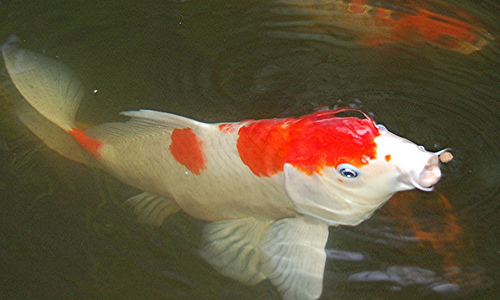
This variant features a white body with red spots. It’s one of the most classic Koi Fish varieties and is highly prized for its simplicity and elegance.
Taisho Sanke
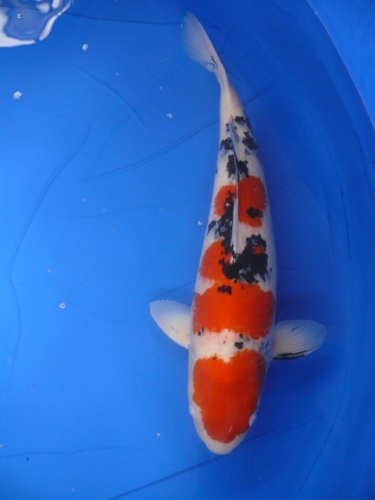
Similar to the Kohaku, the Taisho Sanke has a white body but is characterized by both red and black spots. The balance and placement of the three colors can greatly influence the fish’s value.
Showa Sanshoku
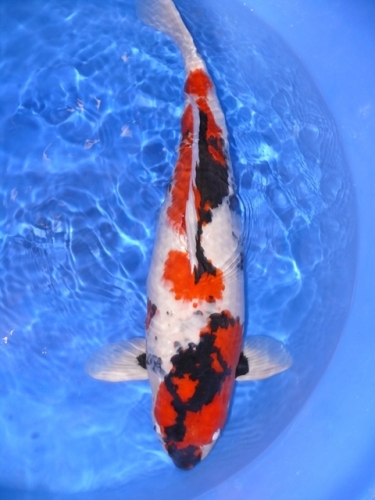
This variant is known for its black body, which is adorned with red and white spots. A good Showa Sanshoku has a pleasing balance of all three colors.
Utsurimono
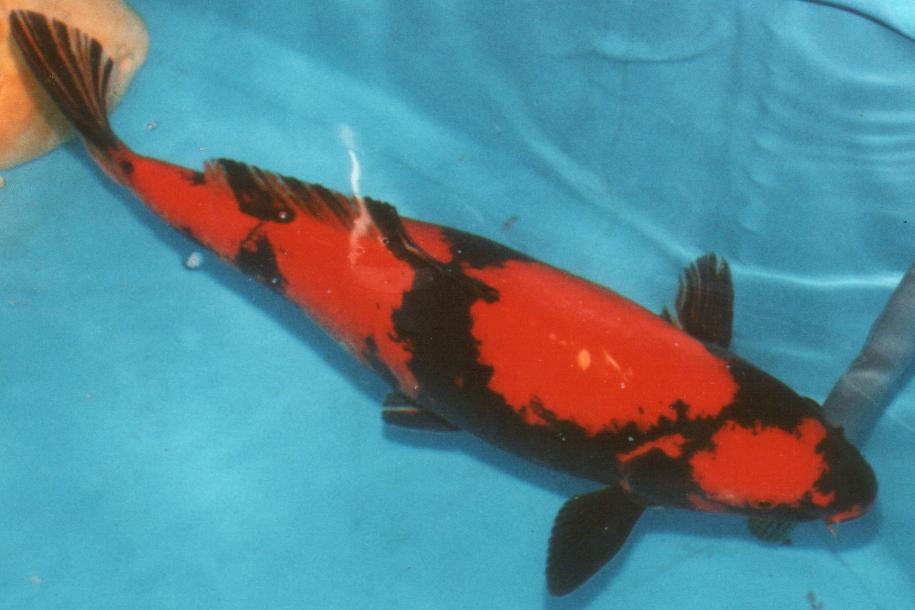
This is a black Koi Fish with either red, white, or yellow markings. The contrast between the dark body and the bright markings is quite striking.
Bekko
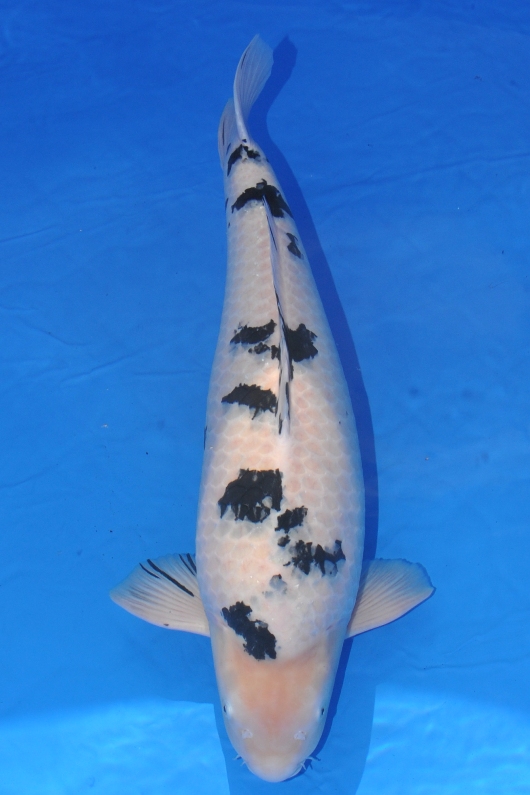
A Bekko Koi Fish has a solid white, red, or yellow body with black spots scattered across it.
Asagi
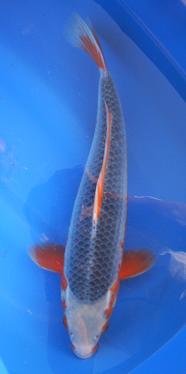
This variant is known for its light blue scales and a red or orange belly, fins, and gills.
Shusui
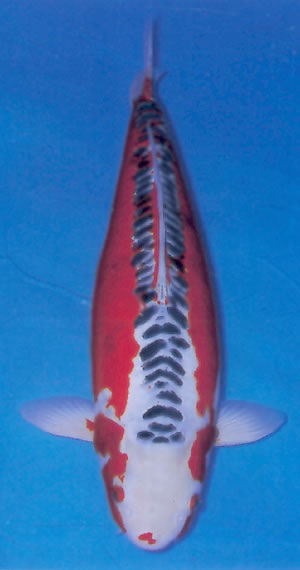
The Shusui is the scaleless version of the Asagi, featuring the same coloration but a smoother body.
Koromo
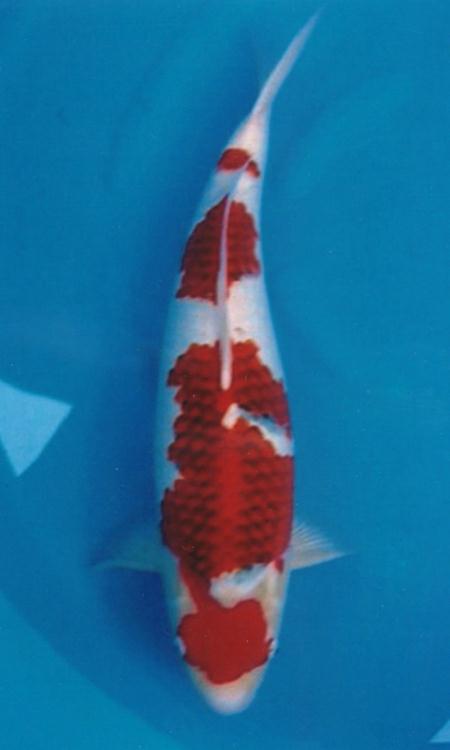
These Koi Fish are either Kohaku, Sanke, or Showa but with blue-edged scales, giving them a unique, robed appearance.
Goshiki
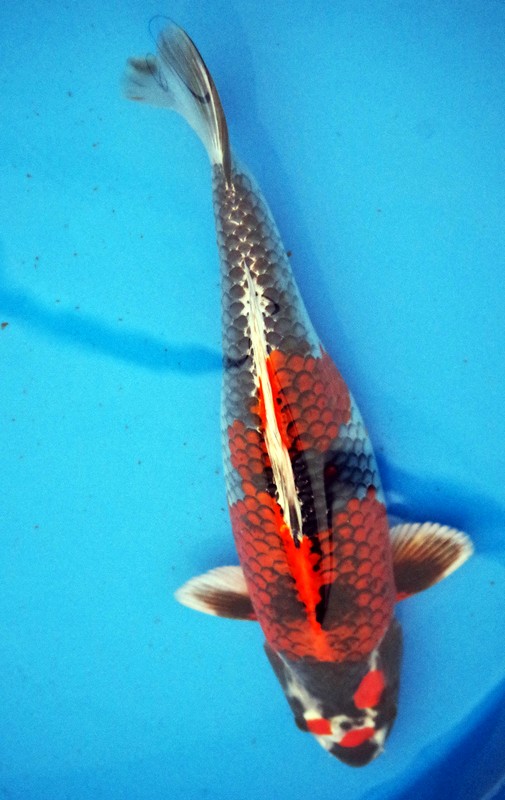
This variant has a black background with a red, white, blue, and dark blue pattern.
Ogon
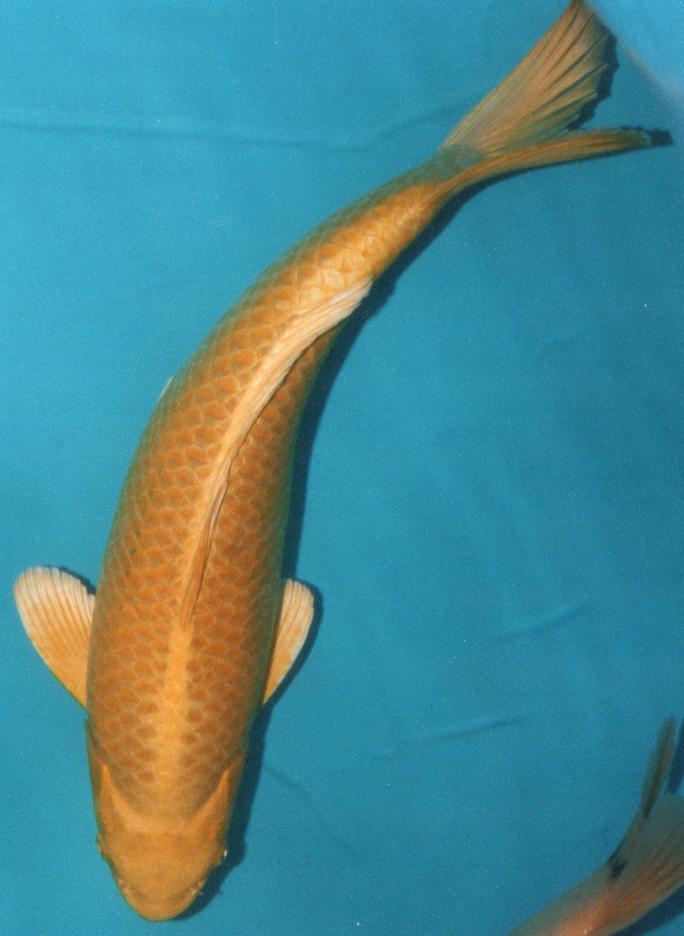
This is a single-colored Koi Fish, which can be either metallic or non-metallic. Common colors include platinum, gold, and orange.
Each of these variants brings its own charm to a pond or water garden, and part of the joy of keeping Koi Fish is in appreciating their diverse beauty.
Creating the Perfect Home: Pond Size and Water Parameters
Creating the perfect environment for your Koi Fish is crucial for their health and happiness. This involves considering the size of the pond and the water parameters.
Pond Size
Koi Fish are active swimmers and can grow to be quite large, so they require a spacious environment. A pond for Koi Fish should ideally be at least 1,000 gallons in volume and at least 3 feet deep. This allows for adequate swimming space and also helps in maintaining stable water parameters. A larger pond also provides better protection against predators and harsh weather conditions. If you’re planning to keep multiple Koi Fish, you’ll need to increase the size of the pond accordingly. As a general rule, you should have 200 gallons of water for each adult Koi Fish.
Water Parameters
Maintaining the right water parameters is essential for the health of your Koi Fish. Here are the key parameters you need to monitor:
- Temperature: Koi Fish are cold-water fish and can tolerate a wide range of temperatures. However, they do best in water that’s between 59-77°F (15-25°C). Extreme temperatures can stress the fish and make them more susceptible to disease.
- pH Level: The pH level of the water measures how acidic or alkaline it is. Koi Fish prefer slightly alkaline water, with a pH level between 7.0-7.5. Fluctuations in pH can be harmful, so it’s important to regularly test the water and adjust the pH as necessary.
- Water Hardness: Koi Fish are adaptable and can tolerate a range of water hardness levels. However, a moderate level of hardness is generally best, as it helps to buffer the pH and keep it stable.
- Ammonia, Nitrite, and Nitrate Levels: These are waste products that can build up in the water and become toxic to fish. Ammonia and nitrite levels should always be zero in a well-maintained pond. Nitrate levels should be kept low through regular water changes and the use of live plants, which absorb nitrates.
- Oxygen Levels: Koi Fish need well-oxygenated water to thrive. You can increase oxygen levels in the pond by using aeration devices like waterfalls, fountains, or air stones.
Regular testing of your pond’s water is crucial to ensure these parameters stay within the ideal ranges. By providing your Koi Fish with a spacious pond and maintaining the right water conditions, you’ll create a perfect home where they can thrive.
The Longevity of Koi Fish: Lifespan and Full Size
Koi Fish are renowned for their longevity and size, with some individuals breaking records in both aspects. Understanding these aspects of Koi Fish can help you provide them with the care they need to live long, healthy lives.
Lifespan
On average, Koi Fish live for about 25-35 years, which is already impressive compared to many other fish species. However, with optimal care and under the right conditions, they can live much longer. In fact, there are records of Koi Fish living well beyond the average lifespan. The oldest known Koi Fish, named Hanako, lived to be 226 years old. Hanako’s age was determined by counting the rings on her scales, much like how the age of a tree is determined by counting the rings in its trunk. Hanako lived in Japan and passed away in 1977, leaving behind a legacy that continues to fascinate Koi Fish enthusiasts.
Full Size
Koi Fish are also known for their substantial size. A full-grown Koi Fish can reach up to 3 feet in length and can weigh up to 35 pounds. The size of a Koi Fish can be influenced by several factors, including genetics, diet, and the size of their environment. Koi Fish need plenty of space to grow, and they can become stunted if kept in a pond that’s too small. The largest Koi Fish on record measured 4.2 feet in length. This record-breaking Koi, named Big Girl, lived in the United Kingdom and was considered one of the largest Koi Fish in the world.
These records highlight the incredible potential of Koi Fish in terms of both lifespan and size. As a Koi Fish owner, it’s important to provide your fish with a spacious pond, a balanced diet, and regular care to help them reach their full potential.
Understanding Their Needs: Natural Environment, Behavior, Habitat Preference, and Pond Design
To provide the best care for your Koi Fish, it’s important to understand their natural environment, behavior, habitat preferences, and the ideal design for their pond.
Natural Environment
Koi Fish are freshwater fish that originally come from Eastern Asia, where they inhabit slow-moving, shallow bodies of water like rivers and ponds. They are used to a climate with four distinct seasons and can tolerate a wide range of temperatures, from near-freezing in the winter to warm temperatures in the summer.
Behavior
Koi Fish are known for their peaceful and social behavior. They are typically active during the day and enjoy swimming around their pond, often in groups. Koi Fish are also known to be quite interactive and can recognize their owners, often swimming up to the surface to greet people or ask for food.
Habitat Preference
Koi Fish prefer a spacious pond with plenty of room to swim. They are bottom dwellers but also enjoy coming to the surface, especially during feeding times. They prefer a pond with a mix of sun and shade, and they need hiding spots where they can retreat if they feel threatened. Koi Fish also prefer a pond with a muddy bottom, which resembles their natural habitat and provides a place for them to forage for food.
Pond Design
When designing a pond for Koi Fish, there are several factors to consider. The pond should be at least 3 feet deep to protect the Koi from predators and to provide a cool retreat during hot weather. It should also have a variety of plant life, which provides shade, hiding spots, and a natural food source. However, be careful to avoid plants that are toxic to Koi. The pond should also include a filtration system to keep the water clean and well-oxygenated, and a heater may be necessary if you live in a climate with cold winters.
A proper filtration system is crucial for maintaining a healthy environment in your Koi pond. The filtration system helps to remove waste products, excess food, and potentially harmful chemicals from the water, keeping it clean and safe for your Koi Fish.
There are three main types of filtration that a Koi pond needs: mechanical filtration, biological filtration, and chemical filtration.
Mechanical Filtration: This type of filtration physically removes solid particles from the water, such as uneaten food, fish waste, and plant debris. This is typically achieved using a filter with a physical medium, such as foam or mesh, that traps these particles. The filter will need to be cleaned regularly to remove the trapped debris.
Biological Filtration: This type of filtration involves using beneficial bacteria to break down harmful waste products, such as ammonia and nitrite, into less harmful substances. These bacteria live on surfaces within the filter and in the pond itself, such as on rocks and plants. A biological filter provides a large surface area for these bacteria to colonize.
Chemical Filtration: This type of filtration uses chemical media to remove dissolved substances from the water that can’t be removed by mechanical or biological filtration. For example, activated carbon can be used to remove certain chemicals and improve water clarity.
When choosing a filtration system for your Koi pond, you’ll need to consider the size of your pond and the number of fish you have. As a general rule, your filtration system should be able to process the entire volume of your pond at least once every two hours. However, for heavily stocked ponds, a higher turnover rate may be necessary.
In addition to a filtration system, you’ll also need a pump to move the water through the filter and back into the pond. The pump should be powerful enough to circulate the entire volume of the pond at least once every two hours.
Incorporating these elements into your pond design will help create an environment that meets your Koi Fish’s needs and closely resembles their natural habitat. This will help your Koi thrive and live a long, healthy life.
Choosing the Right Company: Pond Mates and Fish to Avoid
Koi Fish are peaceful creatures that can coexist with a variety of other fish species. However, it’s important to choose their pond mates carefully to ensure a harmonious environment. Similarly, there are certain fish species that should be avoided as they may not be compatible with Koi Fish.
Pond Mates
Koi Fish can get along well with a variety of other peaceful, non-aggressive fish species. Here are a few examples:
- Goldfish: Goldfish are a popular choice as they are also cold-water fish and have similar care requirements to Koi Fish. They are peaceful and can coexist well with Koi Fish.
- Plecos: Plecos, or sucker-mouth catfish, can be good pond mates for Koi Fish. They are peaceful and can help keep the pond clean by eating algae.
- Other types of carp: Other types of carp, such as the grass carp or the silver carp, can also coexist well with Koi Fish. They have similar needs and behaviors and can add variety to your pond.
Fish to Avoid
While Koi Fish are generally peaceful, they can be bullied or harmed by certain types of fish. Here are a few types of fish to avoid:
- Large Cichlids: Large cichlids can be aggressive and may bully or harm your Koi Fish. They are also tropical fish and may not thrive in the same conditions as Koi Fish.
- Predatory Catfish: Some types of catfish are predatory and can harm or eat smaller Koi Fish. It’s best to avoid these species.
- Small, delicate fish: Small, delicate fish may not be a good match for Koi Fish. Koi can be quite boisterous and may unintentionally harm smaller, more delicate fish.
When choosing pond mates for your Koi Fish, it’s important to consider not only their compatibility in terms of behavior but also their environmental needs. The best pond mates for Koi Fish are those that thrive in similar conditions and can coexist peacefully with them.
Feeding Your Koi Fish: Best Foods/Diet
Feeding your Koi Fish a balanced and varied diet is essential for their health and well-being. Here’s a list of the best foods to include in your Koi Fish’s diet:
- Commercial Koi Food: Commercially prepared Koi food is a staple in the diet of Koi Fish. These foods are specially formulated to provide a balanced diet and come in various forms such as pellets, sticks, and flakes. They contain a mix of proteins, carbohydrates, fats, vitamins, and minerals that Koi Fish need for healthy growth and development.
- Vegetables: Koi Fish are omnivores and enjoy a variety of vegetables. Leafy greens like lettuce, spinach, and kale can be a great addition to their diet. Other vegetables like peas, broccoli, and cucumber are also well-liked by Koi Fish. Make sure to wash the vegetables thoroughly and blanch them to soften them before feeding.
- Fruits: Fruits can be a healthy treat for your Koi Fish. They enjoy a variety of fruits like watermelon, oranges, and apples. Remember to remove any seeds and cut the fruit into small, manageable pieces.
- Live Foods: Live foods such as earthworms, brine shrimp, and daphnia can provide valuable protein for your Koi Fish. These can be a great supplement to their diet but should not make up the majority of their food intake.
- Insects and Larvae: Insects and their larvae, such as mealworms and silkworms, are a natural food source for Koi Fish and can be a nutritious addition to their diet.
- Grains and Cereals: Cooked rice, wheat germ, and cereals can also be included in your Koi Fish’s diet. These provide carbohydrates and can be especially beneficial during the colder months when Koi Fish need more energy.
Creating New Life: Breeding Tips
Breeding Koi Fish can be a rewarding experience, but it requires careful planning and preparation. Here are some tips to help you successfully breed your Koi Fish:
1. Choose the Right Fish: Start by selecting healthy, mature Koi Fish for breeding. Typically, Koi Fish are ready to breed when they are about 3-5 years old. Choose fish with characteristics that you want to pass on to the next generation, such as color, pattern, and size.
2. Provide the Right Environment: Koi Fish usually breed in the spring when the water temperature rises to about 68°F (20°C). Make sure your pond is clean and has plenty of places for the female Koi Fish to lay her eggs. This could be on plants, rocks, or special spawning brushes that you can add to your pond.
3. Encourage Spawning: Male Koi Fish will chase the female around the pond, encouraging her to release her eggs. This can be quite a vigorous process, and it’s important to monitor your fish to ensure the female is not becoming too stressed or injured.
4. Protect the Eggs: Once the eggs have been fertilized, they will stick to whatever surface they were laid on. At this point, it’s often necessary to move the eggs to a separate tank to protect them from being eaten by the adult Koi Fish. The eggs should hatch in about 4-7 days.
5. Care for the Fry: Koi Fish fry are very small and will need to be fed a diet of specially formulated fry food or infusoria (a type of aquatic microorganism) until they are big enough to eat regular Koi Fish food. It’s also important to keep the water quality in the fry tank high, as the fry are very sensitive to changes in water conditions.
6. Grow Out the Fry: Once the fry are a few weeks old, they can be moved to a larger grow-out pond where they have more room to grow. At this stage, you can start to see some of the color patterns developing, but it can take up to a year for the full-color pattern to emerge.
In the tranquil world of Koi Fish, every ripple in the water tells a story of beauty, resilience, and harmony. These vibrant creatures, with their mesmerizing colors and patterns, are more than just ornamental additions to your pond. They are symbols of peace, love, and friendship, bringing a sense of serenity and tranquility to any environment they inhabit. As you embark on your journey of Koi Fish care, remember that every moment spent by the pond is an opportunity to connect with nature, find inner peace, and appreciate the simple joys of life.
As you watch your Koi Fish glide effortlessly through the water, remember that each one is a living work of art, a testament to the beauty of nature’s palette. From the shimmering gold of the Ogon to the striking contrast of the Showa Sanshoku, each Koi Fish is unique, each one a masterpiece. So, whether you’re a seasoned Koi Fish keeper or just beginning your journey, take a moment to appreciate these beautiful creatures. After all, in the dance of the Koi Fish, we find a reflection of life itself – vibrant, graceful, and full of surprises.
FAQs
Can Koi Fish live in a tank?
While it’s possible for Koi Fish to live in a tank, they are better suited to large outdoor ponds. Koi Fish need plenty of space to swim and grow, and they thrive in a more natural environment with plenty of fresh air and sunlight.
How can I tell if my Koi Fish is healthy?
Healthy Koi Fish are active and have bright, vibrant colors. They should have a good appetite and show no signs of physical damage or disease, such as spots, sores, or unusual growths. Their fins should be intact and they should not show any signs of distress, such as gasping for air or rubbing against objects.
How can I improve the color of my Koi Fish?
The color of your Koi Fish can be influenced by several factors, including genetics, diet, and overall health. Feeding your Koi Fish a balanced diet that includes high-quality Koi food and a variety of fruits and vegetables can help enhance their colors. Keeping your Koi Fish healthy and stress-free can also help improve their coloration.
Can Koi Fish survive winter?
Yes, Koi Fish can survive winter, even in climates where the pond may freeze over. They go into a state of semi-hibernation and stay at the bottom of the pond where the water is warmer. It’s important to maintain a hole in the ice to allow for gas exchange and prevent the pond from becoming oxygen-depleted.
Can Koi Fish live with turtles?
While it’s possible for Koi Fish to coexist with turtles in a pond, it’s not typically recommended. Turtles can be aggressive and may injure or eat the Koi Fish. They also have different care requirements and can introduce bacteria into the water that can be harmful to Koi Fish.
What is the symbolism of Koi Fish?
Koi Fish are often associated with positive qualities such as courage, perseverance, and ambition. In Japanese culture, they are seen as symbols of love and friendship. The different colors of Koi Fish also have their own meanings. For example, a red or orange Koi is often associated with love and passion, while a black Koi can symbolize overcoming adversity.
How can I tell the difference between male and female Koi Fish?
Male and female Koi Fish can be difficult to distinguish, especially when they are young. However, mature males often have a more streamlined shape and may have rough patches on their pectoral fins and gill covers during the breeding season. Females tend to be larger and have a rounder body shape, especially when they are carrying eggs.
How can I tell if my Koi Fish is pregnant?
Koi Fish don’t get pregnant in the way mammals do, as they are egg-layers. However, when a female Koi is ready to spawn, she will become noticeably rounder as she fills up with eggs. This is often referred to as being “gravid.” You may also notice male Koi chasing the female more than usual, which is typical pre-spawning behavior.
Can Koi Fish live alone?
While Koi Fish can technically live alone, they are social creatures and generally prefer the company of other Koi. Keeping a single Koi may result in a lonely and stressed fish. It’s usually recommended to keep Koi in groups of at least three.
Can Koi Fish eat bread?
While Koi Fish can eat bread, it’s not recommended to feed it to them regularly. Bread doesn’t provide the necessary nutrients that Koi Fish need and can cause digestive issues. It can also pollute the water as it breaks down. It’s best to stick to a diet of high-quality Koi food and occasional treats of fruits, vegetables, and live foods.

